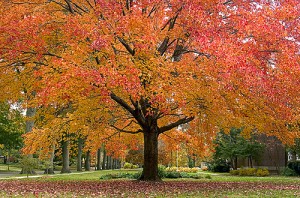We don’t really think about watering our trees and shrubs (or other plants, for that matter) during the winter since snow is made up of water, after all. However, since the ground is often frozen and it is difficult for water to reach the roots, it is essential that you follow a special watering schedule in the fall so that you will have the best possible outcome for your trees and shrubs.
Beginning of Fall
As fall begins, you should stop watering your trees and shrubs for a few weeks. Rainfall should take care of the plants’ needs naturally. If you were to water at this time, the tree would start sending out new leaves and growth. When the first frosts hit, this would be a recipe for disaster as the tender stems are susceptible to cold damage. Let the deciduous trees finish up their leaf change and food storage. Evergreen trees will not change their leaves, of course, nor will they entirely stop growing during the winter. It is especially important that you make sure they get some watering before frosts.
Late Fall
Once the leaves have changed colors and fallen off, you should start watering again as needed. If it is raining frequently, you do not need to worry about doing this. As is the case with your lawns, you do not want to water frequently and shallowly. Do a deep watering every few days to encourage the roots to dive downward. This will help them find water during the winter and be protected from freezing temperatures.
As soon as the first frosts start occurring, stop watering your trees and shrubs. This is especially important if there is snow on the ground. If you have added enough water, your trees and shrubs will have a better chance of surviving the drought conditions of winter.
Image by Andrew Morrell Photography under a Flickr Creative Commons Attribution-NoDerivatives License



